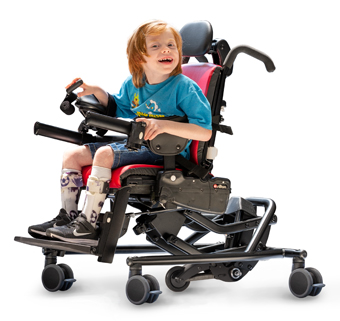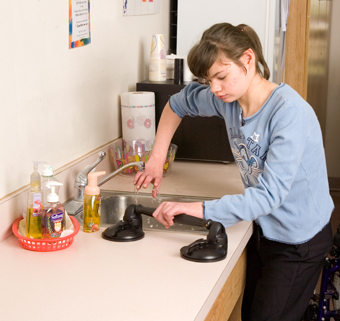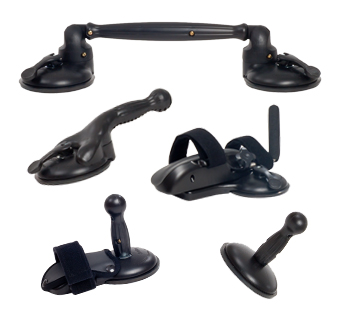Stabilizing the Pelvis with the Rifton Pelvic Harness
| February 2020
 For clients who contend with muscle weakness, it is important to stabilize the pelvis when in the sitting position. To understand why, consider the anatomy and kinesiology of the hip and pelvis. The hip joint moves between an angle of more stability or a “closed-packed” position when in full extension to one of more mobility or an “open-packed” position when in flexion.
For clients who contend with muscle weakness, it is important to stabilize the pelvis when in the sitting position. To understand why, consider the anatomy and kinesiology of the hip and pelvis. The hip joint moves between an angle of more stability or a “closed-packed” position when in full extension to one of more mobility or an “open-packed” position when in flexion.
Standing reflects the closed-packed configuration when the ball and socket joint is locked into place, eliminating almost all motion. Stability is provided through the tightening of the ligaments around the hip as the body moves into standing. Conversely, if the hip moves toward flexion, it approaches the open-packed position. The ligaments loosen and the hip joint becomes more mobile. The position of the hips in a typical sitting posture falls at a point mid-way between the closed- and open-packed extremes.
The structure of the ischial tuberosities of the pelvis adds an additional consideration. Because the tuberosities are rounded, they can be compared to the rockers of a rocking chair and further contribute to movement of the pelvis in the seated posture.
Considering the bodily mechanics of both the hip joint and the pelvis in sitting, the stabilizing factor of muscular activity becomes important to maintain the hip, pelvis and trunk in an erect seated posture. Since the hip joint is in an “unlocked” position in the sitting posture, it depends on active muscles for stability.
However, for clients with disabilities who struggle with muscle weakness, imbalance, spasticity and sensory issues, coordinating muscle activity for stabilization is challenging if not impossible.
Slouched posture, sacral sitting and sliding out of the chair are frequent concerns. In these cases, external pelvic support is necessary to facilitate functional sitting posture. External stabilization for the pelvis also reduces the excessive energy expenditure and muscle fatigue that occurs in the absence of support. Ideally, a seated pelvic stabilization system will both support upright sitting and allow the individual to shift weight in sitting, thereby encouraging the learning of postural control and functional movement with practice.
Traditionally, therapists have implemented a seat belt over the greater trochanters, rigid stabilizers across the front of the pelvis and knee blocks to provide a posteriorly directed force. They have also used abductors between the knees or distal thighs to prevent the pelvis from sliding forward. These approaches, though moderately successful, can create poor positioning, discomfort and adverse pressure to the skin or joints if applied incorrectly.
Fortunately, as our understanding of adaptive seating advances, so do the solutions and positioning options to address positioning needs. One comfortable and effective design for pelvic stabilization is Rifton’s pelvic harness, an accessory of the Activity Chair. This unique design secures the individual’s pelvis comfortably on the seat, holding the pelvis in a neutral position while the backrest supports the back.
Stabilizing the pelvis improves trunk control, which in turn increases head control and shoulder girdle mobility. The goal of external support is not to make the child or client look perfect, but rather to enable freedom of movement in relation to gravity and to improve function in relation to environment. Without appropriate support, pelvic thrusting and/or a sacral sitting position with a posterior pelvic tilt can limit or impede head and trunk control, and may contribute to further musculoskeletal problems.
As a physical therapist working with children who have special needs, Lori Myers, MSPT from Brooklyn, NY, has seen significant improvement that the pelvic harness has achieved in positioning and function, with two of her students.
 “It’s always exciting to see students thrive when certain pieces of equipment and accessories make a huge difference in their position or function. I’ve been working in pediatrics for thirty years and have always appreciated Rifton Equipment. Rifton products are versatile, easy to adjust, well-built and innovative. I was at a Rifton in-service when a product specialist held up a pelvic harness. My eyes opened wide. That was it: exactly what I was looking for.”
“It’s always exciting to see students thrive when certain pieces of equipment and accessories make a huge difference in their position or function. I’ve been working in pediatrics for thirty years and have always appreciated Rifton Equipment. Rifton products are versatile, easy to adjust, well-built and innovative. I was at a Rifton in-service when a product specialist held up a pelvic harness. My eyes opened wide. That was it: exactly what I was looking for.”
 “I had two very physically involved students on my caseload. Both were using Rifton Activity Chairs with a regular seat belt. Yaacov just kept popping out from the seat because of his extensor tone. Nachum was getting sores on the inside of his thighs from the abductor. In fact, Nachum needed to use a Hensinger neck collar for head support in addition to the headrest on the Activity Chair.”
“I had two very physically involved students on my caseload. Both were using Rifton Activity Chairs with a regular seat belt. Yaacov just kept popping out from the seat because of his extensor tone. Nachum was getting sores on the inside of his thighs from the abductor. In fact, Nachum needed to use a Hensinger neck collar for head support in addition to the headrest on the Activity Chair.”
“I knew if I could find a way to keep the pelvis in place, the student would maintain better upright sitting. Sure enough, the pelvic harness did it. Yaacov is now able to sit more upright without the butterfly harness or an abductor. Nachum doesn’t need the abductor and no longer gets sores on the inside of his thighs. He can even be without the butterfly harness or Hensinger neck collar at times throughout his day.
 “The pelvic belt for these two students really made a difference in their ability to sit more upright and to sit more comfortably which in turn improved their ability to attend to learning at school.”
“The pelvic belt for these two students really made a difference in their ability to sit more upright and to sit more comfortably which in turn improved their ability to attend to learning at school.”
In cases where positioning is a challenge, the pelvic harness has become a popular substitute for the regular seatbelt. The harness is first secured to the chair seat and laid out flat with the wide portion towards the back. After the client sits down, the flexible straps are brought between the individual’s thighs, over each leg and anchored near the greater trochanter. This applies an outward, downward and posteriorly directed force which prevents the pelvis from thrusting and/or sliding forward in the seat.
Compared to a traditional lap belt, this form of support is notably more proximal, secure and comfortable, and maintains a better position of the pelvis even for those with strong extensor patterns, bulky clothing or varying girth measurements.
Assuring a stable foundation at the pelvis is more important than many parents and caregivers realize. Pelvic stability influences not only shoulder girdle mobility, head control, feeding and communication as well. It is up to therapists and seating technicians to convey how crucial pelvic stabilization is and to explore the options available to achieve this important aspect of positioning.




